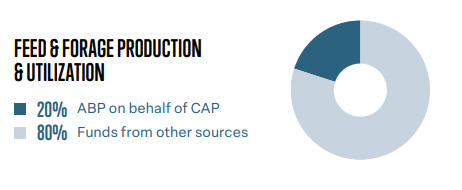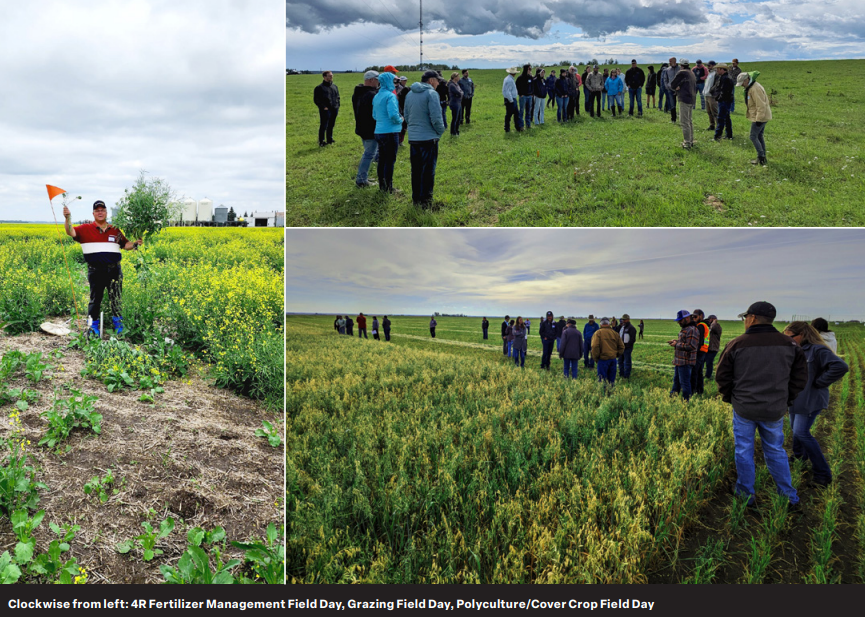AB Direct - Steers
Rail: 492.00-493.50 FOB feedlot (last week)
AB Direct - Heifers
Rail: 492.00-493.50 FOB feedlot (last week)
US Trade- Steers
Rail: 355.00-363.00 (IA, NE) last week
US Trade - Heifers
Rail: 355.00-363.00 (IA, NE) last week
Canadian Dollar
0.19

2023 Annual Report: Beef Production and Extension
ABP’s producer-led research committee makes funding decisions after reviewing proposals received through the Agriculture Funding Consortium. Decisions are guided by the Five-Year Canadian Beef Research and Technology Transfer Strategy, and all full proposals undergo a scientific technical review.

Over the last year, ABP committed $75,000 to five projects with a total project value of over $1.2 million for a leverage ration of $16.84:1.

- Project topics: improved footrot vaccine, development of a mucosal vaccine against Mannheimia haemolytica, the relationships between maternal nutrition and calf immune fitness in extended grazing production systems, breeding more stress tolerant alfalfa, and alternatives to antimicrobials
2019-2023 Feed and Forage Production and Utilization Call Summary
- 19 projects supported
- $3 million invested on behalf of the Canadian Agricultural Partnership Program, total project value over $12.2 million, leverage ratio $4.09:1
- Selected project highlights:
- Development of fecal near infrared spectroscopy calibrations for forage intake and digestibility
- Including higher concentrations of forage early in a finishing ration and decreasing forage proportion as the feeding period progresses can reduce minor liver abscesses to a similar degree as including Tylosin in the ration, and without affecting growth performance, carcass quality, or cost of gain
- New feed and forage barley varieties released: AB Wrangler, AB Tofield, AB Prime, AB Hague, AB Maximizer, AB Standswell
- Preliminary investigation of virtual fencing (NoFence technology) shows significant promise
- Production of the Beef Cattle Health and Nutrition Podcast, hosted by Dr. John Campbell
Alberta Agrisystems Living Lab (AALL)
We couldn’t be happier about the response to this program to date. A huge thank you to our producer participants, our partners and supporters, the AALL contract staff, Canfax Research Services, Nu Nenne Advisian Environmental, and our research leads and their teams from Agriculture and Agri-Food Canada and the University of Alberta for getting us this far.
Living Labs brings research to reality
The AALL is focused on measuring the impacts of beneficial management practices (BMPs) on profitability, productivity, greenhouse gas emission reduction and carbon sequestration in the following areas:
- Cropping systems and crop rotations
- Land use changes
- Nutrient management (fertilizer and manure
- Grazing management
- Livestock feeding
- Carbon on the whole farm (where can you maximize carbon sequestration on a particular landscape)
- Soil health impacts
29 producers across Alberta have implemented, or will be implementing, one or more of 14 BMP’s on their operations.
- Intercropping
- Cover cropping
- Pasture/hayland rejuvenation/improvement
- Adaptive multi-paddock/rotational grazing
- Extended grazing (bale/swath, corn)
- Cropland conversion to perennial cover
- Polyculture or polycropping (annual and perennial)
- Forage diversification (legume overseeding)
- Soil improvement via amendments
- Wetland restoration
- Optimization of fertilizer use (including 4R, EEF, split application, nitrification inhibitor, etc)
- Manure and compost management/application
- Precision feeding
- Precision farming (seeding and fertilizing)
Baseline measurements are mostly complete with first year soil, forage, and crop measurements and analysis underway. The AALL also held three summer field days, two soil workshops with Indigenous communities, and a webinar so far in 2023. In addition, we are currently analyzing the results of our Adoption Rate Survey which will provide valuable insight into baseline rates of adoption of several of these BMPs. Other data currently under analysis includes cost of production and information required to estimate baseline GHG and carbon storage on these operation using the Holos model. Cost-benefit modelling of selected BMPs is beginning later this year (with more to follow in subsequent years), and we are also examining non-financial drivers of adoption related to producer values and attitudes.

Stay tuned for more AALL online events through the rest of 2023 and join us for more learning opportunities in 2024!
- ABP was very pleased with the federal announcement made earlier this year regarding funding for a food and mouth disease (FMD) vaccine bank. ABP continues to work closely with CCA, other commodity organizations, and Animal Health Canada to strengthen Canada’s ability to prepare, respond, and recover in the event of an FMD incursion.
- Proposed changes to the Health of Animals Regulations Section XV – Identification and Traceability were released for comment in March of this year. ABP hosted an industry stakeholder meeting to identify concerns raised by different organizations about the proposed changes and utilized that discussion as well as submissions from other groups to formulate a cohesive response to the proposed changes. While ABP is supportive of improving traceability and recognizes the value of a strong traceability system in Canada, we remain concerned about the costs of, and ability to implement, some of the proposed changes.
- CowBytes is back! This ration balancing software allows producers to formulate their own feed rations.
- Wondering about whether it’s economical to keep and develop replacement heifers? This calculator can help.
This message was originally posted in Alberta Beef Producers’ 2023 Annual Report. You can find the PDF of the report here.


